Author’s Note: Hello out there in SCG Land. Welcome to my series on pimping. I’m not sure how many weeks this is going to span, but I want to take my time with it and go over each aspects of pimping including the pimp culture. Throughout the weeks, I’m going to talk about foreign language cards, foil, special printings, mis-cuts. I’ll teach you how to gain value from pimping, and I’ll even going to introduce you to couple of people who’ve spent a lot of time building a ridiculous collection of pimp Magic cards. I hope you enjoy.
—
My father was a craftsman.
He wasn’t certified in any specific craft, but everything he did carried a strong brand of craftsmanship. As his eldest son and obligatory wingman, I more than anyone else got to witness this first hand.
“Hold it straight, dammit!” My dad re-centered the piece of steel.
I was daydreaming again. I gathered my focus and pushed the steel bar against the sturdy welding table.
“Look away.” He slid his welding helmet down and welded the bars together.
I knew that we were getting close to completing the door. The steel frame was in place, and we only needed to rivet the steel screen to it. This part was easy but tedious.
“Why don’t we just tack-weld it?” I was trying to get out of drilling a hundred holes in the steel frame.
“Because, if you tack weld it, the screen is going to break loose the first time that someone slams the door. We don’t make crap; we’re better than that.”
This was a recurring theme throughout my young life, “Medinas don’t take the easy way; we’re better than that. Instead we take the hard way, and when we build something, we build something great.”
I carried this attitude with me in everything I did, and Magic is no exception. When I started playing, I wanted to win a Pro Tour. I know it’s laughable, but as long as I play Magic, this will be the goal that taunts me. When I started writing about Magic, I wanted to write for the best site (spoiler: I got there) and be the best Magic writer that there is/was (spoiler: still really far off of this one). When I started collecting, I wanted my collection to be the best collection.
Wait. Rewind that.
When I started playing, I didn’t even know that my collection could have a status or a value. I knew that I could make a good deck or the best deck, but I had no idea that my cards formed a “collection”—that my collection could be “better” than someone else’s. My innocence was lost the day I looked into playing Vintage. I saw decks that looked this:

And I wanted so badly for my collection to look like that. I wanted my collection to be the best. I wanted to build something great, but what did it mean to build the best collection?
What Is Pimp?
Once I found out that my collection could be “pimped,” I spent hours on the StarCityGames.com forums in the pimp thread studying the different posts and people’s reactions. I wanted to be sure that someday when I posted my cards that they were truly “pimp.” I didn’t want to look like a chump. Through a process of elimination, a hierarchy emerged. For example, someone would post a Chinese foil Engineered Explosives, and other people on the thread would respond with things like “Eww” or “Moar Japanese.” These responses taught me that Japanese was more desirable than Chinese. Over time, I developed my understanding of the hierarchy, and it’s helped me make solid trades. It’s helped me to value my cards properly and see when people are undervaluing theirs.
Before I jump into the hierarchy, I should say that this is only a guideline to help you determine the value of a pimp card. If you ask anyone who is pimping their collection, “What is pimp?” they’ll tell you that pimp is in the eye of the beholder. For example, even though black borders are typically preferred to white borders, I met a guy who was obsessed with white-border cards. He tried to get everything for his deck in white borders because to him white borders were pimp. For the purposes of this article, we’ll consider people like “white-border guy” the outliers.
Generally pimp cards are worth more because they are harder to find (or rarer) that plain English cards. The mentality of someone who is trying to pimp his or her deck/collection is to try and make it the most unique and most rare that they can. You’ll see in the hierarchy that the more rare the card is, the higher in the hierarchy it will be. The basic pimping hierarch is as follows:
Foreign Set Foils (highest form of pimp)
Set Foils
Foreign Cards
Signed Cards
Promotional Cards (lowest form of pimp)
There are also crimped cards, mis-cuts, and altered art cards, which can fall into different levels of the pimp hierarchy depending on the card and the alter or the level of severity of the mis-cut/crimp. For example, the most pimp Library of Alexandria that you can get is probably one that is altered by Eric Klug and signed/doodled on by the artist. This is because there are no foils or foreign language versions of this card. This week we’re going to focus primarily of foreign languages.
Languages
In the United States, foreign language cards have a big draw, but in most other countries, English cards are preferred. I don’t know the exact reason for this, but there are two explanations that come to mind. The first is that English cards are their version of “pimp” because it’s a foreign language. I tend to dismiss this as a possibility because English is the most printed language, by far. This makes English the least rare and least pimp (see note below). The other possibility is that English cards have a wider market for resale; therefore they are more valuable in other countries. For example a Japanese vendor who sells in Japan and through eBay would rather have an English version of the card because there are more potential customers for it.


Another example of this is Portal Three Kingdoms. This set was primarily printed in Japanese / Chinese and released in Asia-Pasic. The set had a small English print run and was never officially released in the US. This means that English versions are more expensive than the non-English versions.


Did you know that and English Imperial Seal is worth $700? This sucks because I still need one for my Vintage deck.
Some vendors in Japan realize this exchange and use it as a strategy to make a profit. They travel to American GPs and other big tournaments to trade Japanese foils to Americans for English cards. They gain value on both ends of the transaction by trading Japanese players English cards at a premium for their Japanese foils, then trading the Japanese foils at a premium to Americans for their English cards. It’s important to understand the motivations and systems behind the flow of the market because it can help you when dealing in high-end Japanese foils, but let’s not get ahead of ourselves. Let’s talk about which languages are more pimp than the others.
Language Hierarchy
As you can see there are a lot of different things going on with foreign (foreign for me, obviously they are native to some of you reading) language Magic cards. Different countries have different rules and different business processes. I have a faint picture of what these rules look like, but the only country that I can speak with any authority on is the United States. In the Unites States there is a hierarchy of foreign languages. Each language has some “need-to-know” details and a pricing multiplier unique to the language. Let’s start at the top and work our way down.
Korean
This is the most desired language. Only a handful of sets were printed in Korean; these sets include: Fourth Edition, Fifth Edition, Mirage, Visions, Weatherlight, Tempest, Stronghold, Exodus, and Urza’s Saga. One of the reasons that Korean is in such high demand is because the sets that it was printed in don’t offer foils. For a long time, the most pimp Wasteland you could get was an altered Korean Wasteland. The same is true for cards like Yawgmoth’s Will and Goblin Lackey. I put a Korean card below; train your eye (it could make you some money). The oval-circles are a dead giveaway that the card is Korean.
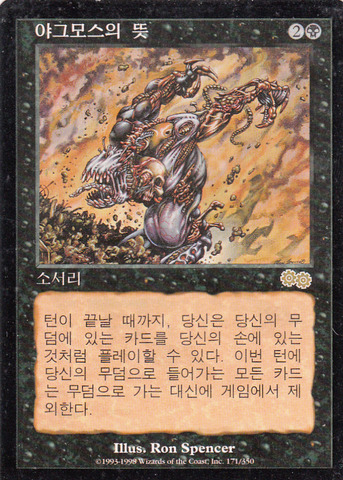
Pricing Modifier: Pricing a Korean card can be tricky; they are typically worth very little or infinite. If you have something like a Korean Disenchant, then you can’t expect to get much out of it unless you find a collector (there are pimper versions of Disenchant, and the card is not played that much). If you have something like a Korean Yawgmoth’s Will, then it’s worth many times more than its English counterpart. I sold one for $80 to a dealer earlier this year. If I were to sell the Yawgmoth’s Will for retail, I’d probably be asking for around $130.
Look at the Nevinyrral’s Disk below; the Korean version is about 8x the Star City price for a regular English one ($6 versus $50). This is because the only other option for a pimp Nevinyrral’s Disk is the foil one in From the Vaults: Relics, and some pimp purists don’t consider that pimp (we’ll talk more about this when we talk about foils).

Korean Is Back
Before I move on to the other languages, I just wanted to make a note that Korean will be returning with M12 and Innistrad (Official Announcement). This means that all cards that are playable in Legacy, Vintage, and EDH will carry a heavy premium (as will their foils). Cards like Timely Reinforcements and Mayor of Avabruck, which see play primarily in Standard will have prices that are close to their Japanese counterparts.
Japanese
For now, Japanese is still seated firmly in its place as second most pimp language. It’s the most common among pimp cards in the US; this could be attributed to the high demand for Japanese cards in the States. The Japanese language does not contain ovals like Korean does, and it’s less blocky than Chinese. On newer cards, you can also see very small characters above the letters in Japanese but not Korean or Chinese. See the example below.
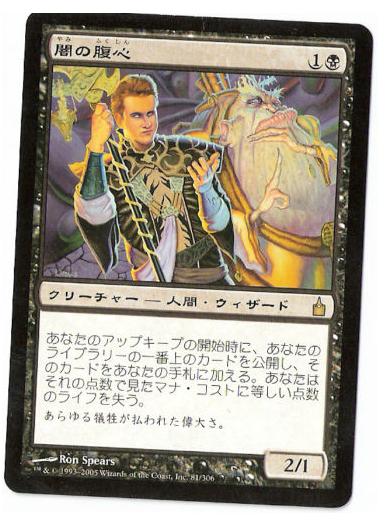
Pricing Modifier: Typically the modifier for English to Japanese is between 35% and 65%. That seems like a wide gap, but it depends on the card and the formats that it get’s played in. Non-rotating formats lend themselves to pimping since you can invest in them without losing your shirt after rotation. A card like Champion of the Parish, which is hot in Standard but sees no play in other formats, will be closer to 35% markup ($5 to $6.75), but a card like Jace, the Mind Sculptor would be closer to the 65% markup ($60 -$100).
Russian
This is the language that has been snapping at the heels of Japanese for its place as the second most pimp language. It seems to be harder to find in the Unites States, and I wouldn’t be surprised to see it overcome Japanese at some point. I’ve been trying to pick up Russian foils when I can in preparation for the shift in trends. Russian often has letters that look backwards and a script style with some lines being thicker than others.
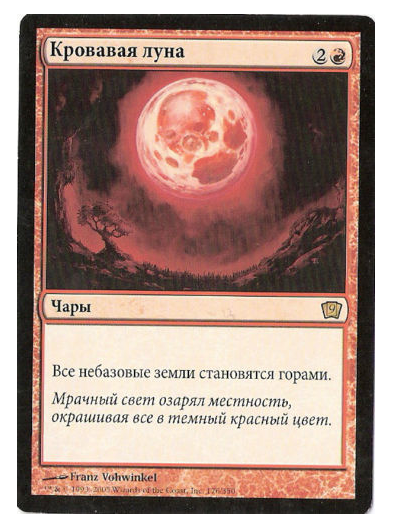
Pricing Modifier: The pricing modifier is not as good as Japanese, but it’s close. The modifier is about 25% to 45%, and it follows the same rules as Japanese in regard to the non-rotation format playables.
German
This is actually the most pimp language for some cards. If a card was not printed in any of the languages above, then German is the most pimp by default. This is true of any language in the hierarchy, but it’s particularly relevant for German because of the cards that fall in to this category. For example, the most pimp Force of Will that you can get is German. The same is true of Foreign Black-Bordered (FBB) dual lands. Naturally, the most pimp dual land you can get is NM Alpha or Beta, but if you don’t have a million dollars lying around, then you’ll probably be looking at FBB. The only descriptor that I can give here is German looks like German.

Pricing Modifier: If we’re talking about Force of Will (and cards in the same category) then the price modifier is closer to the Japanese modifier 30%-55%. If we are talking about average run-of-the-mill cards, then the modifier is very low. It’s around 5% to 10%, if that. This low modifier also applies to foreign white-border cards. Which means that a German white-border Bayou is not worth much more than an English one.
The Rest (Romance Languages and Chinese)
Corner cases can be made for some of these languages and their rarity. For example French is more desirable than Italian when you are dealing in FBB Dual lands or when you’re shopping for your playset of Delay. But they all typically fall in the same category.
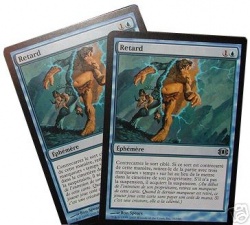
Keep in mind that Chinese cards are often worth less than English cards because after each set release, eBay is flooded with Chinese cards at low prices. It’s a common mistake for people who are just getting into pimping to buy Foil Chinese cards because they are Asian language and they’re cheaper than Japanese. The problem is that these oftentimes end up being worth less than English foils because of the amount that hit the market. It’s also worth noting that people with cubes often want English foils because they play with a mix of people who may not know what the card does. Look at the Chinese card, and notice that it’s more blocky than Japanese.
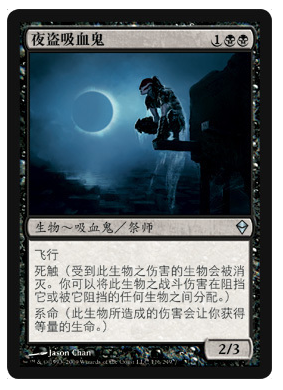
As a trader/dealer I usually avoid these languages unless someone has specifically asked for them or I’m dealing with a corner case.
Pricing Modifier: This could range from positive percentile to negative percentile, meaning that a card could be worth more than double its English counterpart (see the corner cases like the French Delay), or it could be worth less than the English version (see Chinese Gideon Jura); it’s all relative to the situation, but 90% of the time it’s better to stick with English.
Next Week
That’s all I have for this week. Next week I’m going to talk about foils and promos along with some other cool stuff. See you next week and thanks for reading!
Jonathan
